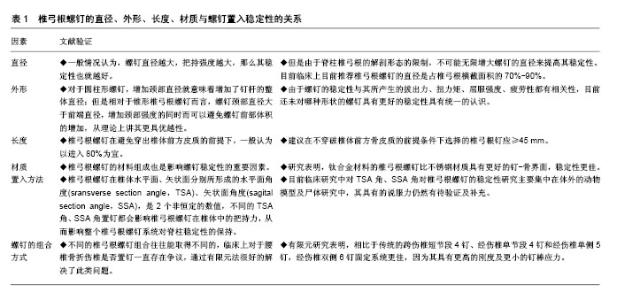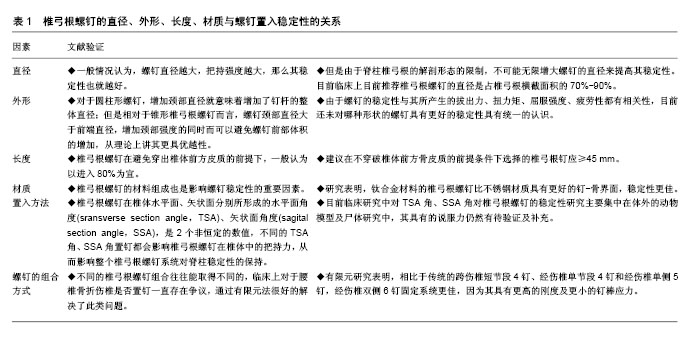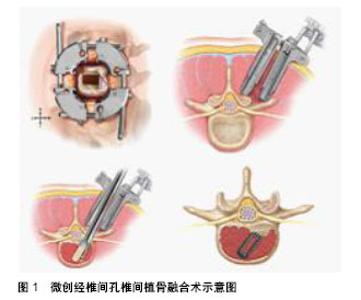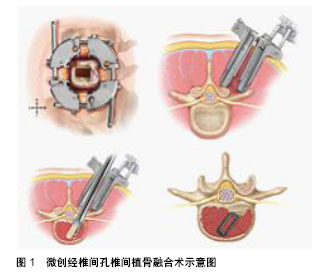Chinese Journal of Tissue Engineering Research ›› 2018, Vol. 22 ›› Issue (19): 3091-3096.doi: 10.3969/j.issn.2095-4344.0258
Previous Articles Next Articles
Biomechanical properties of the lumbar pedicle screws by finite element analysis
Wei Bing, Xu Ze-chuan, Chang Shan
- Department of Orthopedics, the First Affiliated Hospital of Chengdu Medical College, Chengdu 610500, Sichuan Province, China
-
Online:2018-07-08Published:2018-07-08 -
Contact:Chang Shan, Master, Chief physician, Professor, Department of Orthopedics, the First Affiliated Hospital of Chengdu Medical College, Chengdu 610500, Sichuan Province, China -
About author:Wei Bing, Master, Department of Orthopedics, the First Affiliated Hospital of Chengdu Medical College, Chengdu 610500, Sichuan Province, China
CLC Number:
Cite this article
Wei Bing, Xu Ze-chuan, Chang Shan . Biomechanical properties of the lumbar pedicle screws by finite element analysis[J]. Chinese Journal of Tissue Engineering Research, 2018, 22(19): 3091-3096.
share this article

2.1 有限元的概念及发展史 20世纪50年代,飞机设计师们发现用之前的力学方法来分析新型飞机的结构变得越来越困难。1956年工程师Turner[2]、土木工程教授Clough等首次将有限元法应用于力学计算,标志着有限元法正式登上历史舞台。1960年Clough在自己的论文中首次提出“有限元法”这个名称。1965年国内的冯康发表论文“基于变分原理的差分格式”,这标志着中国开始独立发展有限元方法。有限元法的基本概念即是把一个复杂整体分解为有限个简单物体的组合来模拟、计算、分析的方法,简而言之即是先化整为零的分析,然后积零为整的研究方法。有限元分析法的优势在于可将具有不规则外形结构的物体分割成许多可以单独负载的简单小单元,从而评估整个不规则物体结构的受力情况,先离散、后整合的方法是有限元法的最基本思想。 应用有限元法分析物体受力过程中,其计算量往往较大,靠人工完成比较费时费力,这就需要计算机及先进的数据处理软件来完成快速的计算,随着计算机技术的不断发展,有限元法所研究对象也逐渐发生改变,到20世纪60年代中期以前研究的主要是小应变、小位移、静力分析及弹性材料,之后逐渐开始研究材料的非线性、热分析、大变形和杆件屈曲等问题。最近又跟医学的发展紧密相连,并在骨科中得到充分的利用。20世纪70年代Brekelmans利用放射平片成功建立了腰椎间盘二维有限元模型[3],首次将有限元法应用于骨科生物力学分析。有趣的是,CT和MRI也是从20世纪70年代开始应用于临床,但是其与有限元法都是在各自的领域独自发展,直至20世纪末,进行数字图像处理所需要的设备包括摄像机、数字图像采集器(包括同步控制器、模数转换器及帧存储器)、图像处理计算机和图像显示终端以及第4代计算机快速发展等硬件设施的提高,数字图像处理技术有机的将有限元法和数字图像有机结合在一起,形成了今天大家所熟悉的数字医学有限元分析技术。1988年Goel等[4]首次通过CT扫描数据成功建立了腰椎的复杂三维有限元模型。在CT扫描中骨与软组织的对比度高,所以其能够精确的描述骨骼几何形态;同时CT值亨氏单位(hounsfield unit,HU)与骨骼的表观密度具有类似的线性关系[5],所以其能够较精确描述骨骼的材料特性。目前大多数研究都选择基于CT数据来建立模型,但是其仍不能很好解决肌肉、血管等软组织模型的建立。总结起来,骨科有限元模型建立经历了相对简单的二维模型到以CT扫描和三维重建技术为基础的数字化有限元模型,并在一定程度上完善了脊柱椎间盘、连接韧带、椎体间小关节、关节囊等软组织结构的模型建立。 近年来有限元法被广泛应用于正常人体四肢脊柱及软组织的生物力学研究、骨折的受力机制、骨科内固定器械的生物力学、内植物应力遮挡及内固定器械设计等。 2.2 椎弓根螺钉的发展史 1949年Michele、Krueger第一次描述了椎弓根的解剖,并且使用了螺钉从后路经椎弓根置入椎体。20世纪60年代Bouche[6]首次报道了螺钉经椎弓根到椎体用于临床治疗,并且获得了较好的治疗效果。1986年Gaines等[7]首次使用椎弓根螺钉-骨折模型来演示负荷通过椎体和内固定器械一起共同传递受力的重要意义,这就是有名的“负荷分享”,其较大的促进了椎弓根螺钉的临床应用,同年Stefee等[8]发明了可滑动槽式的钢板,使得椎弓根螺钉的置入点可根据个体差异进行灵活调整。经过几十年的发展,椎弓根螺钉内固定系统有了长足的发展,其主要有Roy-Camille椎弓根内固定系统、RF椎弓根内固定系统、Graf韧带形成术、动态平衡系统(Dynesys)、带支柱的软固定系统(FASS)。 2.3 有限元在脊椎椎弓根螺钉方面的研究 脊柱椎弓根螺钉内固定系统符合脊柱固定的生物力学要求,能够有效的固定脊柱前中后三柱,已经成为了脊椎外科最为常用的内固定系统。同时有限元法也是目前医用生物力学研究的热点。广大的研究中也开始利用三维有限元法建立数字化模型来模拟研究椎弓根螺钉的生物力学特征并指导临床应用以及新器械的研发。椎弓根螺钉通过穿过狭长的椎弓根到达椎体内而起到固定作用,目前的研究表明,椎弓根螺钉的稳定性主要与螺钉的直径、外形、长度、材质、置入方法、螺钉的组合方式密切相关,见表1。"


2.3.1 螺钉的直径、外形、长度、材质 螺钉的直径是影响螺钉稳定性的重要因素之一,不同直径的椎弓根螺钉有着显著不同的生物力学特征。一般情况认为,螺钉直径越大,把持强度越大,那么其稳定性也就越好。Zhang等[9]通过有限元法分析也证实了随着椎弓根螺钉的外径逐渐增大,骨-螺钉界面的刚度及拔出力也逐渐增加,其稳定性也越佳。但是,由于脊柱椎弓根的解剖形态的限制,不可能无限增大螺钉的直径来提高其稳定性。有研究指出,椎弓根螺钉的横截面积占椎弓根横截面积低于70%时螺钉易产生疲劳性松动,只有≥70%以上时螺钉的稳定性才能得到保证,而当其提高到90%及以上时,螺钉的固定强度及稳定性并没有进一步提高,但是其发生医源性椎弓根骨折的概率却明显增加,所以目前临床上目前推荐椎弓根螺钉的直径是占椎弓根横截面积的70%-90%[10-11]。在腰椎模型中给椎弓根螺钉施加轴向、前曲、后伸、旋转、左侧屈和右侧屈6种生理负荷后,发现螺钉底部与螺纹的交界处是椎弓根螺钉的应力主要集中点,且下方螺钉更为集中,这一结果支持临床上75%的螺钉断裂发生在下端螺钉的事实,所以有学者建议在椎弓根螺钉置入过程中下位螺钉应适当选择较粗的,以增加力学强度,减少螺钉疲劳断裂的概率。 螺钉的外形是螺钉的重要参数,圆柱形螺钉和锥形螺钉是目前临床上最常见到的2种螺钉。2种形状的椎弓根螺钉在临床上都有报道产生了松动。有学者在下胸段及腰段使用锥形与圆柱形2种椎弓根螺钉来研究其生物力学差异,比较得出相同直径的锥形与圆柱形螺钉具有相近的最大拔出力,但是锥形螺钉的扭矩更高[12]。大量体外生物力学试验证实,椎弓根螺钉置入椎体后,位于椎体内的钉杆部分主要承受约束力,椎体外的钉尾端主要承受压应力,而螺钉的屈服点主要集中在螺钉颈部,同时临床报道椎弓根螺钉断裂、弯曲最常见的区域是直径越小的螺钉颈部。因此使用颈部拥有更大直径的螺钉就理所当然可以提高螺钉的强度及刚度,提高螺钉的稳定性。对于圆柱形螺钉,增加颈部直径就意味着增加了钉杆的整体直径,但是相对于锥形椎弓根螺钉而言,螺钉颈部直径大于前端直径,增加颈部强度的同时而可以避免螺钉前部体积的增加,从理论上讲其更具优越性。Hsu等[13]通过有限元分析及体外力学实验均证实了圆锥形螺钉相对于圆柱形螺钉具有更高的拔出力和扭力矩。但是Chao等[14]对圆锥形和圆柱形螺钉进行研究后发现圆柱形螺钉能够产生更大的屈服强度和疲劳寿命。由于螺钉的稳定性与其所产生的拔出力、扭力矩、屈服强度、疲劳性都有相关性,目前还未对哪种形状的螺钉具有更好的稳定性具有统一的认识。 Weinstein等[15]研究表明螺钉整体强度的60%是在脊柱椎弓根内,持续向前达到椎体松质骨时则增加至75%-80%,如果继续往前穿破椎体前方骨皮质则可达到 80%-85%的固定力,但是穿破皮质会损伤椎体前方的血管及其他重要结构,造成不良的并发症,所以椎弓根螺钉在避免穿出椎体前方皮质的前提下,一般认为以进入80%为宜。国内漆伟等[16]利用螺钉-骨复合体模型对30,35,40,45,50 mm椎弓钉螺钉进行对比研究表明增加螺钉在椎体内的长度能使螺钉、皮质骨及松质骨上的轴向应力分布更加均匀,所以建议在不穿破椎体前方骨皮质的前提条件下选择的椎弓根钉应≥45 mm。 另外椎弓根螺钉的材料组成也是影响螺钉稳定性的重要因素。Christensen等[17-19]在对比研究钛合金和不锈钢两种材质的椎弓根螺钉中表明,骨与螺钉表面直接接触面积不锈钢组为29.4%,而钛合金组为43.8%,这就表明了钛合金材料的椎弓根螺钉比不锈钢材质具有更好的钉-骨界面,稳定性更佳。 2.3.2 螺钉的置入方法 在排除螺钉的长度、形状、材质等影响因素后,螺钉的进针点及方向明显影响了椎弓根螺钉的稳定性。 目前大多数术者在手术过程中都是通过横突及上关节突的位置来确定螺钉置入的进钉点。从大体解剖位置上看,上关节突较横突更加接近椎弓根管开口,上关节突下缘连线与其外侧缘垂线的交点处就是椎弓根开口中心,目前临床上主要的进针点有Roy-Camille、Magerl、Krag、AO推荐的4种[20]。椎弓根螺钉在椎体水平面、矢状面分别所形成的TSA角及SSA角是2个非恒定的数值,不同的TSA角、SSA角置钉都会影响椎弓根螺钉在椎体中的把持力[21-22],从而影响整个椎弓根螺钉系统对脊柱稳定性的保持,由于椎弓根的高度一般情况下远大于它的宽度,所以选择TSA角更为重要,选择更好的TSA,可以使螺钉的螺纹与椎弓根外围的骨皮质有更好的嵌合。由于术者选择的进针点不同,其进钉的角度在水平面及矢状面也存在着差异。Roy-Camille等[1]建议椎弓根螺钉应平行椎体上下终板置入,即螺钉在矢状面呈0°。Magerl[23]则认为螺钉在矢状面呈15°夹角力学效果更佳。Krag等[24]提出螺钉应向内上方倾斜置入,这样可使其拔出的强度增大[25]。“AO”则推荐在胸腰段螺钉的置入应向中线倾斜5°左右,L2-L5倾斜10°-15°[26]。王正 等[27]研究比较平行置入和矢状面7°置入,发现后者拔出力增加20%,其弯曲刚度两者增加25%,证明倾斜置入螺钉更符合力学原则。但是也有研究利用AO螺钉平行椎弓根固定与矢状面成角 4°-16°不等固定相比较,发现角度对螺钉的拔出强度影响不明显;另外也有研究者通过对椎弓根螺钉7°朝向椎体上终板、7°朝向椎体下终板、平行终板3种不同角度置入来测试螺钉的弯曲力矩,结果发现3种不同角度置入方式其椎体内螺钉弯曲力矩没有明显差异。Sterba等[28]发现头倾置钉相对于传统平行置钉可使螺钉螺纹把持更多椎体的骨皮质,使螺钉获得更大的抗拔出力;同时Santoni等[29]则改变传统置入的钉道,沿侧方皮质骨直接置入进一步完善了上述置钉角度的改变,最大程度地利用椎弓根复合体骨面,维持内固定的生物力学强度。国内有学者通过三维有限元法进一步研究在单个椎体中通过皮质骨钉道置钉,结果表明皮质骨钉道置入的椎弓根螺钉载荷位移较传统平行置钉更大,证明经皮质骨钉道置钉的椎弓根螺钉稳定性更佳。目前临床研究中对TSA角、SSA角对椎弓根螺钉稳定性影响的研究主要集中在体外的动物模型及尸体研究中,其具有的说服力仍然有待验证及补充。 2.3.3 椎弓根螺钉的组合方式 Lim等[30]通过有限元模型模拟研究椎弓根螺钉内固定系统在不同横连下的力学效应,证实使用水平方式连接横向连接杆能改善脊柱在旋转及侧弯运动中的稳定性,且在纵向连杆的1/2和1/8处可取得最大的力学效应,研究还表明对角线斜行连接连接杆可以增强脊柱在曲伸活动中的稳定性,但是其增加椎弓根钉局部应力[31]。Kuklo等[32]的研究表明一个横向连接杆即可明显降低轴向旋转应力,提高稳定性,2个连接杆效果更佳。Alizaden等[33]通过建立的腰椎爆裂性骨折模型模拟分析长节段、短节段与不同横连连接联治疗椎体骨折的力学效应,结果表明长节段椎弓根螺钉固定较短节段固定稳定性更佳,且X形状的连接棒可提高14.9%的固定刚度,且减小66.7%临近节段应力,明显增加了椎体骨折椎弓根螺钉内固定系统的稳定性。 不同的椎弓根螺钉组合往往能取得不同的,临床上对于腰椎骨折伤椎是否置钉一直存在争议,通过有限元法很好的解决了此类问题。2013年Li等[34]通过有限元法建模比较了经伤椎置6钉和传统的跨伤椎4钉在胸腰段脊柱骨折治疗钟的生物力学特征,结果显示6钉系统固定时,椎弓根各螺钉的应力较4钉明显减少,且2种内固定系统下伤椎椎体最大位移无差异,因此认为经伤椎置6钉固定更佳,其可明显减少螺钉断裂等并发症的发生。2014年Li等[35]利用有限元研究表明,相比于传统的跨伤椎短节段4钉、经伤椎单节段4钉和经伤椎单侧5钉,经伤椎双侧6钉固定系统更佳,因为其具有更高的刚度及更小的钉棒应力。国内学者对6钉系统不同的置钉方式做了更加深入的研究,谭磊等[36]建立L3椎体的不稳定性骨折模型,通过比较水平短钉、水平长钉、斜向长钉、斜向短钉4种不同方式的生物力学效应,结果显示4组轴向位移及弯曲角度差别不大,在前屈及后伸状况下,斜钉组的椎弓根螺钉的最大应力较水平置钉组更小,表面经伤椎斜向下固定可以避免螺钉应力集中,从而能更有效地预防内固定断裂、退钉等发生。 近年来,微创手术在临床中越来越流行(图1)。张 良[37]建立了L3-4节段的经后路椎间植骨融合术有限元模型和经椎间孔椎间植骨融合术有限元模型,来验证哪种手术方式取得的力学效果更优,结果表明经椎间孔椎间植骨融合术和经后路椎间植骨融合术都能取得相似的力学稳定性,但是经椎间孔椎间植骨融合术的融合器较经后路椎间植骨融合术发生沉降的概率更小,经椎间孔椎间植骨融合模型中的椎弓根螺钉最大应力较相应的经后路椎间植骨融合模型更小,证明了经椎间孔椎间植骨融合术可能较经后路椎间植骨融合术更优,同时从侧面证实了椎板、棘突及后方韧带复合体等椎体后部结构在腰椎稳定性方面起着较为重要的作用。余伟波等[38]在建立正常L3-5有限元模型上模拟了3种不同经椎间孔椎间植骨融合后路内固定方式:单侧椎弓根螺钉内固定组、双侧椎弓根螺钉内固定组、单侧+对侧关节突螺钉固定组,结果显示所有内固定方式中,融合节段的活动范围均明显下降,其中以双侧组下降最多,关节突螺钉组的螺钉承担的应力最大,左侧弯时达234.9 MPa;双侧组中的椎间融合器及螺钉的应力最小。表明了后路双侧椎弓根螺钉固定能获得最佳稳定性,且能降低椎间融合器的下沉及移位的风险。Xu等[39]构建了单纯内固定和内固定联合骨水泥强化的椎体螺钉2种有限元模型来研究其生物力学效应,结果表明骨水泥强化后明显减小了椎弓根螺钉内固定系统和脊柱的应力,进一步研究表明,对于直径6.5 mm的椎弓根螺钉,螺钉外径周围3.4 mm的环形区域为应力分布有效区域,对于骨质疏松患者的内固定系统有效强化注入2.6 mL骨水泥最佳[40-41]。 同时,有限元法在新型内固定器械的研发上也有着不小的贡献。汪宇等[42]对自行设计的椎弓根钉复合椎板钩内固定系统进行了有限元分析,证实增加使用椎板钩可使两端椎弓根螺钉的根部及连接处的应力降低。 2.4 有限元法在椎弓根螺钉应用中的优缺点 脊柱椎弓根螺钉的有限元建模需要许多可靠的参数,由于椎体、韧带、椎间盘、腰椎肌肉等组织的力学性质极其复杂,生物特性无绝对的分界线,目前还没有哪一种统一的标准来真实的反映其生物特性;再加上在模型的构建过程中需要划分单元、选择节点、加载载荷及边界条件的选择上也无统一的规定,使得构建的模型存在误差,导致有限元模型不可能完全模拟出真实受力,与实际受力有较大的出入;另外由于椎弓根螺钉的有限元模型建立中需要将螺纹网格化,越小的网格化越能反映螺钉最真实状态,但无限的网格化会增加后期数据再处理的难度,甚至导致后期计算进入死循环而无法得到最终的结果,所以寻找一个最佳的网格化数据点又是一大难点。但是,有限元法能在相当大的程度上代替传统的生物力学实验,且能控制实验条件和模拟活体运动状态下的力学情况,既往的脊柱生物力学研究分析,多采取全息照相、电测等方法,对骨性结构特别是椎体的表面结构研究较多,而对骨骼内部的力学研究稍欠缺,这样就难以做到全面分析脊柱的生物力学[43]。但椎弓根螺钉的有限元分析能很好的反映螺钉、螺钉-骨复合体、螺钉系统及椎体内部的力学情况,能对不同角度置入、不同受力方式及椎体不同运动状态下的负荷进行较为全面的分析,同时数字化有限元模型具有可重复计算、节约时间经费、结果精确度高、有效回避了伦理学问题等优点[44-45]。 "

| [1] Roy-camille R,Saillant G,Mazel C. Internal fixation of the lurmbar spine with pedical screw Plating.Clin Orthop. 1986;203:7-11.[2] Turner M,Martinh C. Stiffness and defilection analysis complex structure. Aero Sci. 1956;23(9):805-809.[3] Belytschko T,Kulak RF.Finite element stress analysis of an intervertebral disc.Biomech. 1974;7(3):277-285.[4] Goel VK,Kim YE,Lin TH,et al. An analytical investigation of the mechanics of spinal instrumentation. Spine. 1998;13(5):1003-1007.[5] 苏春涛, 眭承志.腰椎三维有限元生物力学分析的技术应用进展[J].中国康复医学杂志,2013,28(5):1001-1242.[6] Boucher HH.A method of spine fusion. J Bone Joint Surg.1959;41(5): 248-259.[7] Gaines RW,Carson WL. Experimental evaluation of Seven diferent spinal fraetare irdermal fixation devices using nonfailure stability testing.The wad-sharing and unstable-mecha-nism concepts. Spine. 1990;15:11-14.[8] Stefee AD, Biscuplt S, SitRowsid DJ. A new internal fixation device for disorders of the lumbar and thoraco-lumbar spine. Clin Orthop. 1986; 203:45-53.[9] Zhang QH, Tan SH, Chou SM. Effects of bone materials on the screw pull-out strength in human spine. Med Eng Phys. 2006;28(8):795-801.[10] 敖俊,方国芳,冯伟,等.以三维有限元模型分析短节段腰椎椎弓根螺钉系统固定后螺钉应力的分布[J].中国组织工程研究与临床康复, 2008,12(39): 7601-7604.[11] 王宇,靳安民,方国芳,等.腰椎椎弓根螺钉系统断裂的三维有限元分析[J].中国组织工程研究与临床康复,2008,12(48):9439-9442.[12] Chen CS,Chen WJ,Cheng CK,et al.Failure analys is of broken pedicle Screws on spinal Instrumentation.Med Eng Phys. 2005;27:487-496.[13] Hsu CC,Chao CK,Wang JL,et al.Increase of pullout strength of spinal pedicle screws with conical core:biomechanical tests and finite element analyses.J Oethop Res. 2005;23(4):78-94.[14] Chao CK, Hsu CC, Wang JL, et al. Increasing Bending Strength and Pullout Strength in Conical Pedicle Screws:Biomechanical Tests and Finite Element Analyses. J Spinal Disord Tech. 2008;21(2):130-138.[15] Weinstein JN,Rydevik BL,Rauschning W.Anatomic and technical considerations of pedicle screw fixation.Clin Orthop Relat Res.1992; (284):34-46.[16] 漆伟,雷伟,严亚波.椎弓根螺钉长度变化对螺钉-骨复合体模型应力影响的三维有限元分析研究[J].医用生物力学,2010,25(3):206-211.[17] Christensen FB,Dalstra M,Sejling F,et al.Titanium-alloy enhances bone-pedicle screw fixation: mechanical and histomorphometrical results of titanium-alloy versus stainless steel.Eur Spine J. 2000;9(2): 97-103.[18] Von Knoch M, Saxler G, Quint U.Titanium as an implant material for rods of transpedicular instrumentation of the lumbar spine. Biomed Tech (Berl).2004;49(5):132-136. [19] Soultanis K,Pyrovolou N,Karamitros A,et al.Instrumentation loosening and material of implants as predisposal factors for late postoperative infections in operated idiopathic scoliosis.Stud Health Technol Inform. 2006;123:559-564.[20] 段洪斌.不同水平角度置入椎弓根螺钉的拔钉生物力学研究[D].吉林大学, 2005.[21] 武启军.脊柱结核单节段椎弓根螺钉内固定的生物力学研究[D].宁夏医科大学,2010.[22] 覃涛,杜远立,郑东.计算机3D建模模拟个体化枢椎椎弓根钉最佳进钉方式的应用[J].中国矫形外科杂志,2014,22(19):1800-1804.[23] Magerl FP. Stabilization of the lower thoracic and lumbar spine with external skeletal fixation.Clin Orthop. 1984;(189):125-141.[24] Krag MH, Van Hal ME, Beynnon BD. Placement of transpedicular vertebral screws close to anterior vertebral cortex.Description of method. Spine. 1989;14(8):879-883.[25] Krag MH, Beynnon BD, Pope MH, et al. An internal fixator for posterior application to short segments of the thoracic,lumbar,or lumbosacral spine. Clin Orthop. 1986;(203):75-98.[26] Muller ME, Allgower M, Schneider R, et al. Manual of internal fixation techniques recommended by the AO ASIF group.3 ed, Springer verleg, Berlin Heidelberg,1991:666-670.[27] 王正,沈国平,陈伟兵,等. 椎弓根螺钉内固定稳定性的生物力学测试[J]. 医用生物力学,2002,17(2):80-84.[28] Sterba W, Kim DG, Fyhrie DP, et al. Biomechanical analysis of differing pedicle screw insertion angles. Clin Biomech. 2007;22(4):385-391.[29] Santoni BG,Hynes RA, Mcgilvray KC,et al.Cortical bone trajectory for lumbar pedicle screws.Spine J. 2009;9(5):366-373.[30] Lim TH, Eek JC, An HS, et al. Biomechanics of transfixation in pedicle screw instrumentation.Spine. 1996;21(19):2224-2229.[31] Lim TH, Kim JG, Fujiwara A, et al. Biomechanical evaluation of diagonal fixation in pediele screw instrumentation.Spine. 2001;26(22): 2498-2503.[32] Kuklo TR, Dmitriev AE, Cardoso MJ, et al. Biomechanical contribution of transverse connectors to segmental stability following long segment instrumentation with thoracic pedicle screws.Spine. 2008;33(15): 482-487.[33] Alizaden M, Kadir MR, Fadhli MM, et al. The use of X- shaped cross-link in posterior spinal constructs improves stability in thoracolumbar burst fracture: a finite element analysis. J Orthop Res. 2013;31: 1447-1454.[34] Li QL, Li XZ, Liu Y, et al. Treatment of thoracolumbar fracture with pedicle screws at injury level: a biomechanical study based on three-dimensional finite element analysis. Eur J Orthop Surg Traumatol. 2013;23:775-780.[35] Li C, Zhou Y, Wang H, et al. Treatment of unstable thoracolumbar fractures through short segment pedicle screw fixation techniques using pedicle fixation at the level of the fracture: A finite element analysis. PLoS One. 2014; 9:e99156.[36] 谭磊,李彦慧,于铁成,等.六钉系统中伤椎不同置钉方式治疗腰椎骨折的有限元分析[J].中华临床医师杂志:电子版,2015,9(19):3558-3562.[37] 张良.PLIF与TLIF对腰椎稳定性影响的有限元分析[D].吉林大学, 2016.[38] 余伟波,梁德,叶林强,等.TLIF 后路不同的内固定方式生物力学特性的比较分析[J].中国临床解剖杂志,2016,34(5):551-556.[39] Xu G, Fu X, Du C, et al. Biomechanical effects of vertebroplasty on thoracolumbar burst fracture with transpedicular fixation: a finite element model analysis. Orthop Traumatol Surg Res. 2014;10: 379-383.[40] Liu S, Qi W, Zhang Y, et al. Effect of bone material properties on effective region in screw- bone model: an experimental and finite element study. Biomed Eng Online. 2014;13:83.[41] Yan YB,Teo EC,Qiu TX,et al.Finite element study on the amount of injection cement during the pedicle screw augmentation.J Spinal Disord Tech. 2013;26:29-36.[42] 汪宇,潘滔,李佛保,等.椎板钩对椎弓根螺钉系统应力影响的有限元分析[J]. 中国临床解剖学杂志,2006,24(2):209-211.[43] 关海山,杨惠林,冯皓宇. 有限元分析肌肉力对胸腰椎运动节段椎间盘压力的影响[J].苏州大学学报(医学版),2007,27(2):209-213,221.[44] 刘雷,沈根标. 胸腰椎脊柱损伤的生物力学及有限元分析[J].实用骨科杂志,2001,7(5):354-357.[45] 张超,李宁宁.有限元法在脊柱内固定生物力学研究中的应用进展[J].临床医学工程,2011,18(10):1684-1698. |
| [1] | Xu Feng, Kang Hui, Wei Tanjun, Xi Jintao. Biomechanical analysis of different fixation methods of pedicle screws for thoracolumbar fracture [J]. Chinese Journal of Tissue Engineering Research, 2021, 25(9): 1313-1317. |
| [2] | Zhang Tongtong, Wang Zhonghua, Wen Jie, Song Yuxin, Liu Lin. Application of three-dimensional printing model in surgical resection and reconstruction of cervical tumor [J]. Chinese Journal of Tissue Engineering Research, 2021, 25(9): 1335-1339. |
| [3] | Chen Xinmin, Li Wenbiao, Xiong Kaikai, Xiong Xiaoyan, Zheng Liqin, Li Musheng, Zheng Yongze, Lin Ziling. Type A3.3 femoral intertrochanteric fracture with augmented proximal femoral nail anti-rotation in the elderly: finite element analysis of the optimal amount of bone cement [J]. Chinese Journal of Tissue Engineering Research, 2021, 25(9): 1404-1409. |
| [4] | Zhou Jihui, Li Xinzhi, Zhou You, Huang Wei, Chen Wenyao. Multiple problems in the selection of implants for patellar fracture [J]. Chinese Journal of Tissue Engineering Research, 2021, 25(9): 1440-1445. |
| [5] | Zeng Yanhua, Hao Yanlei. In vitro culture and purification of Schwann cells: a systematic review [J]. Chinese Journal of Tissue Engineering Research, 2021, 25(7): 1135-1141. |
| [6] | Xu Yulin, Shen Shi, Zhuo Naiqiang, Yang Huilin, Yang Chao, Li Yang, Zhao Heng, Zhao Lu. Biomechanical comparison of three different plate fixation methods for acetabular posterior column fractures in standing and sitting positions [J]. Chinese Journal of Tissue Engineering Research, 2021, 25(6): 826-830. |
| [7] | Cai Qunbin, Zou Xia, Hu Jiantao, Chen Xinmin, Zheng Liqin, Huang Peizhen, Lin Ziling, Jiang Ziwei. Relationship between tip-apex distance and stability of intertrochanteric femoral fractures with proximal femoral anti-rotation nail: a finite element analysis [J]. Chinese Journal of Tissue Engineering Research, 2021, 25(6): 831-836. |
| [8] | Song Chengjie, Chang Hengrui, Shi Mingxin, Meng Xianzhong. Research progress in biomechanical stability of lateral lumbar interbody fusion [J]. Chinese Journal of Tissue Engineering Research, 2021, 25(6): 923-928. |
| [9] | Liu Zhao, Xu Xilin, Shen Yiwei, Zhang Xiaofeng, Lü Hang, Zhao Jun, Wang Zhengchun, Liu Xuzhuo, Wang Haitao. Guiding role and prospect of staging and classification combined collapse prediction method for osteonecrosis of femoral head [J]. Chinese Journal of Tissue Engineering Research, 2021, 25(6): 929-934. |
| [10] | Xie Chongxin, Zhang Lei. Comparison of knee degeneration after anterior cruciate ligament reconstruction with or without remnant preservation [J]. Chinese Journal of Tissue Engineering Research, 2021, 25(5): 735-740. |
| [11] | Xu Dongzi, Zhang Ting, Ouyang Zhaolian. The global competitive situation of cardiac tissue engineering based on patent analysis [J]. Chinese Journal of Tissue Engineering Research, 2021, 25(5): 807-812. |
| [12] | Wu Zijian, Hu Zhaoduan, Xie Youqiong, Wang Feng, Li Jia, Li Bocun, Cai Guowei, Peng Rui. Three-dimensional printing technology and bone tissue engineering research: literature metrology and visual analysis of research hotspots [J]. Chinese Journal of Tissue Engineering Research, 2021, 25(4): 564-569. |
| [13] | Chang Wenliao, Zhao Jie, Sun Xiaoliang, Wang Kun, Wu Guofeng, Zhou Jian, Li Shuxiang, Sun Han. Material selection, theoretical design and biomimetic function of artificial periosteum [J]. Chinese Journal of Tissue Engineering Research, 2021, 25(4): 600-606. |
| [14] | Liu Fei, Cui Yutao, Liu He. Advantages and problems of local antibiotic delivery system in the treatment of osteomyelitis [J]. Chinese Journal of Tissue Engineering Research, 2021, 25(4): 614-620. |
| [15] | Li Xiaozhuang, Duan Hao, Wang Weizhou, Tang Zhihong, Wang Yanghao, He Fei. Application of bone tissue engineering materials in the treatment of bone defect diseases in vivo [J]. Chinese Journal of Tissue Engineering Research, 2021, 25(4): 626-631. |
| Viewed | ||||||
|
Full text |
|
|||||
|
Abstract |
|
|||||